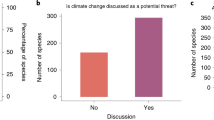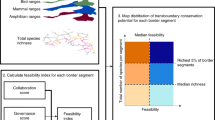Abstract
A climate-driven global redistribution of species is currently underway. As species alter their geographical distributions under climate change, many will not only cross into new habitats but also new geopolitical areas. In this Perspective, we discuss the historical archetypes of managing species redistribution—persecution, protection or ignorance—which points to diverse decisions and outcomes based on a balance of societal and ecological valuation. We build the case for increasing transboundary monitoring and management of species, and for shared governance agreements that are global in scope, consisting of legally binding and biologically defensible contracts among partner countries, in what would be a critical step for the future conservation of all species.
This is a preview of subscription content, access via your institution
Access options
Access Nature and 54 other Nature Portfolio journals
Get Nature+, our best-value online-access subscription
$29.99 / 30 days
cancel any time
Subscribe to this journal
Receive 12 print issues and online access
$209.00 per year
only $17.42 per issue
Buy this article
- Purchase on Springer Link
- Instant access to full article PDF
Prices may be subject to local taxes which are calculated during checkout

Bas Köhler

moose henderson/iStock/Getty Images Plus/Getty (Mountain lion); FiledIMAGE/iStock/Getty Images Plus/Getty (Dingo); Fyn Kynd (Barred owl); yhelfman/iStock/Getty Images Plus/Getty (Brown cowbird); Becky Matsubara (Ringed-neck pheasant); Javier Cooper (Longspine urchin); Jim Hidgins/USFWS (Kirtlands warbler)


Similar content being viewed by others
References
Scheffers, B. R. et al. The broad footprint of climate change from genes to biomes to people. Science 354, aaf7671 (2016). A comprehensive review showing that over 80% of ecological processes considered in terrestrial, marine, and freshwater ecosystems as well as human systems have evidence of observed impact from climate change.
Pecl, G. T. et al. Biodiversity redistribution under climate change: impacts on ecosystems and human well-being. Science 355, eaai9214 (2017). A comprehensive review showing that impacts of species redistribution extends from nature to society.
Chen, I. C., Hill, J. K., Ohlemüller, R., Roy, D. B. & Thomas, C. D. Rapid range shifts of species associated with high levels of climate warming. Science 333, 1024–1026 (2011).
Parmesan, C. & Yohe, G. A globally coherent fingerprint of climate change impacts across natural systems. Nature 421, 37–42 (2003).
Poloczanska, E. S. et al. Responses of marine organisms to climate change across oceans. Front. Marine Sci. 3, 1–61 (2016).
Sunday, J. M., Bates, A. E. & Dulvy, N. K. Thermal tolerance and the global redistribution of animals. Nat. Clim. Change 2, 686–690 (2012).
Pinsky, M. L. et al. Preparing ocean governance for species on the move. Science 360, 1189–1191 (2018). A paper highlighting the complexity of future governance of marine ecosystems under climate change.
Lenoir, J. & Svenning, J. C. Climate-related range shifts – a global multidimensional synthesis and new research directions. Ecography 38, 15–28 (2015).
Both, C., Van Asch, M., Bijlsma, R. G., Van Den Burg, A. B. & Visser, M. E. Climate change and unequal phenological changes across four trophic levels: constraints or adaptations? J. Animal Ecol. 78, 73–83 (2009).
Corlett, R. T. & Westcott, D. A. Will plant movements keep up with climate change? Trend. Ecol. Evol. 28, 482–488 (2013).
Carey, M. P., Sanderson, B. L., Barnas, K. A. & Olden, J. D. Native invaders – challenges for science, management, policy, and society. Front. Ecol. Environ. 10, 373–381 (2012).
Ling, S. D. Range expansion of a habitat-modifying species leads to loss of taxonomic diversity: a new and impoverished reef state. Oecologia 156, 883–894 (2008).
Wernberg, T. et al. Climate-driven regime shift of a temperate marine ecosystem. Science 353, 169–172 (2016).
Webber, B. L. & Scott, J. K. Rapid global change: implications for defining natives and aliens. Glob. Ecol. Biogeo. 21, 305–311 (2012).
Schlaepfer, M. A., Sax, D. F. & Olden, J. D. The potential conservation value of non-native species. Conserv. Biol. 25, 428–437 (2011).
Shine, R. & Doody, J. S. Invasive species control: understanding conflicts between researchers and the general community. Front. Ecol. Environ. 9, 400–406 (2011).
Lawler, J. J. Climate change adaptation strategies for resource management and conservation planning. Ann. NY Acad. Sci. 1162, 79–98 (2009).
Kelly, E. G., Forsman, E. D. & Anthony, R. G. Are barred owls displacing Spotted Owls? Condor 105, 45–53 (2003).
Wayne, R. K. & Jenks, S. M. Mitochondrial DNA analysis implying extensive hybridization of the endangered red wolf Canis rufus. Nature 351, 565–568 (1991).
Crane, A. L., McGrane, C. E. & Mathis, A. Behavioral and physiological responses of Ozark zigzag salamanders to stimuli from an invasive predator: the armadillo. Int. J. Ecol. 2012, 1–7 (2011).
Fitch, H. S., Goodrum, P. & Newman, C. The armadillo in the Southeastern United States. J. Mammal. 33, 21–37 (1952).
Gompper, M. E. Top carnivores in the suburbs? Ecological and conservation issues raised by colonization of North-eastern North America by Coyotes. Bioscience 52, 185–190 (2002).
Brittingham, M. C. & Temple, S. A. Have cowbirds caused forest songbirds to decline? BioScience 33, 31–35 (1983).
Mayfield, H. The Brown-headed Cowbird, with old and new hosts. Living Bird 4, 13–28 (1965).
Rothstein, S. I. The cowbird’s invasion of the far west: history, causes and consequences experienced by host species. Stud. Avian Biol. 15, 301–315 (1994).
Siegle, R. & Ahlers, D. Brown-headed cowbird management techniques manual (US Department of the Interior, 2004).
Head, L. The social dimensions of invasive plants. Nat. Plants 3, 17075 (2017).
Peterson, A. T. & Robins, C. R. Using ecological-niche modeling to predict Barred Owl invasions with implications for Spotted Owl Conservation. Conserv. Biol. 17, 1161–1165 (2003).
Zhang, D. & Hiziroglu, S. Impact assessment and utilization of eastern red cedar. Am. J. Appl. Sci. 7, 1032–1037 (2010).
Guo, D., Arnolds, J. L., Midgley, G. F. & Foden, W. B. Conservation of Quiver trees in Namibia and South Africa under a changing climate. J. Geosci. Environ. Prot. 4, 1–8 (2016).
Probst, J. R., Donner, D. M., Bocetti, C. I. & Sjogren, S. Population increase in Kirtland’s warbler and summer range expansion to Wisconsin and Michigan’s Upper Peninsula, USA. Oryx 37, 365–373 (2003).
Richard, T. Confirmed occurrence and nesting of the Kirtland’s Warbler at CFB Petawawa, Ontario: a first for Canada. Ont. Birds 26, 2–15 (2008).
Harris, J. B. C. et al. Conserving imperiled species: a comparison of the IUCN Red List and U.S. Endangered Species Act. Conserv. Lett. 5, 64–72 (2012).
Poloczanska, E. S. et al. Global imprint of climate change on marine life. Nat. Clim. Change 3, 919–925 (2013).
Fogarty, H. E., Burrows, M. T., Pecl, G. T., Robinson, L. M. & Poloczanska, E. S. Are fish outside their usual ranges early indicators of climate-driven range shifts? Glob. Change Biol. 23, 2047–2057 (2017).
Veit, R. R. Vagrants as the expanding fringe of a growing population. The Auk 117, 242–246 (2000).
Robinson, L. M. et al. Rapid assessment of an ocean warming hotspot reveals “high” confidence in potential species’ range extensions. Glob. Environ. Change 31, 28–37 (2015).
Hughes, T. P. et al. Global warming and recurrent mass bleaching of corals. Nature 543, 373–377 (2017).
Hoegh-Guldberg, O. et al. Assisted colonization and rapidclimate change. Science 321, 345–346 (2008).
Lawler, J. J. & Olden, J. D. Reframing the debate over assisted colonization. Front. Ecol. Environ. 9, 569–574 (2011).
Bonebrake, T. C. et al. Managing consequences of climate-driven species redistribution requires integration of ecology, conservation and social science. Biol. Rev. 93, 284–305 (2018). A comprehensive review on complex management scenarios when considering species redistribution.
VanDerWal, J. et al. Focus on poleward shifts in species’ distribution underestimates the fingerprint of climate change. Nat. Clim. Change 3, 239–243 (2012).
Heller, N. E. & Zavaleta, E. S. Biodiversity management in the face of climate change: a review of 22 years of recommendations. Biol. Conserv. 142, 14–32 (2009).
Scott, J. M. et al. Recovery of imperiled species under the Endangered Species Act: the need for a new approach. Front. Ecol. Environ. 3, 383–389 (2005).
Thornton, D. H. et al. Asymmetric cross-border protection of peripheral transboundary species. Conserv. Lett. 11, e12430 (2018).
Petursson, J. G., Vedeld, P. & Vatn, A. Going transboundary? An institutional analysis of transboundary protected area management challenges at Mt Elgon, East Africa. Ecol. Soc. 18, 28 (2013).
Yong, D. L. et al. Challenges and opportunities for transboundary conservation of migratory birds in the East Asian-Australasian flyway. Conserv. Biol. 32, 740–743 (2018).
Kirby, J. S. et al. Key conservation issues for migratory land- and waterbird species on the world’s major flyways. Bird Conserv. Int. 18, 49–73 (2008).
Yong, D. L. et al. Migratory songbirds in the East Asian-Australasian Flyway: a review from a conservation perspective. Bird Conserv. Int. 25, 1–37 (2015).
Acknowledgements
We are grateful to A. Abolhassani and B. Haas for researching information for Fig. 4. T. Bryant was instrumental in creation of the other figures. G.P. was supported by an ARC Future Fellowship; and B.R.S. thanks Oak Ridge Associate Universities for their support via the Ralph E. Powe Junior Faculty Enhancement Award.
Author information
Authors and Affiliations
Contributions
B.R.S. conceived the study, G.P. and B.R.S. collected data, B.R.S. analysed data, B.R.S. wrote the manuscript with development and revision from G.P.
Corresponding author
Additional information
Peer review information: Nature Climate Change thanks Chrystal Mantyka-Pringle, Morgan Tingley and other, anonymous, reviewer(s) for their contribution to the peer review of this work.
Publisher’s note: Springer Nature remains neutral with regard to jurisdictional claims in published maps and institutional affiliations.
Rights and permissions
About this article
Cite this article
Scheffers, B.R., Pecl, G. Persecuting, protecting or ignoring biodiversity under climate change. Nat. Clim. Chang. 9, 581–586 (2019). https://doi.org/10.1038/s41558-019-0526-5
Received:
Accepted:
Published:
Issue Date:
DOI: https://doi.org/10.1038/s41558-019-0526-5
This article is cited by
-
Mechanisms, detection and impacts of species redistributions under climate change
Nature Reviews Earth & Environment (2024)
-
Climate change and the global redistribution of biodiversity: substantial variation in empirical support for expected range shifts
Environmental Evidence (2023)
-
Glacier retreat reorganizes river habitats leaving refugia for Alpine invertebrate biodiversity poorly protected
Nature Ecology & Evolution (2023)
-
Global impacts of future urban expansion on terrestrial vertebrate diversity
Nature Communications (2022)
-
Climate change and modernization drive structural realignments in European grain production
Scientific Reports (2022)



